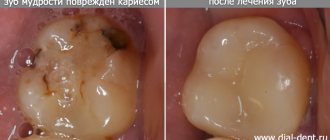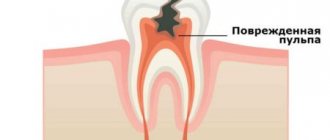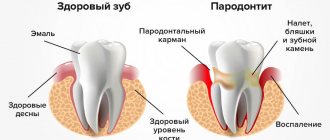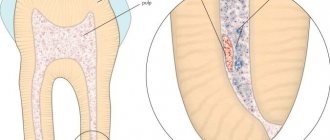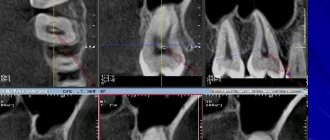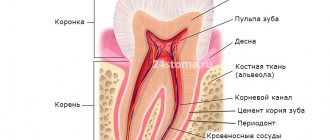Fibrous pulpitis is one of the types of chronic pulpitis. Its characteristic feature is the excessive growth of connective tissue fibers in the tooth cavity, which ultimately leads to impaired blood supply to the pulp and its death.
Seeking professional help for chronic fibrous pulpitis on time is the key to restoring the appearance and functional characteristics of the tooth. At the same time, an advanced disease can lead to the death of the pulp and the spread of the inflammatory process to the periodontium.
It is worth noting that chronic fibrous pulpitis can develop as a result of the lack of treatment for acute pulpitis, and it can also be a primary process without an acute stage. It can appear and develop on both primary and permanent teeth. Treatment of fibrous pulpitis involves surgery.
Filling made of light-curing material for classes I and V - 2,000 rubles.
Filling made of light-curing material in classes II, III, IV - 3,000 rubles.
Placing a temporary filling - 400 rubles.
Resection of the root apex (frontal group) - 6,500 rubles.
Resection of the root apex (chewing group) - RUB 9,000.
Mechanical and medicinal treatment of canals for periodontitis (1 canal) - 1,100 rubles.
Closing perforations (MTA) - RUB 6,500.
At CELT you can get advice from a dental specialist.
- The cost of a dental consultation is 1,000
- The cost of an orthodontist consultation is 2,000
Make an appointment
Etiology of fibrous pulpitis
The reason for the development of the chronic form of the disease is the opening of the coronal dental cavity during acute fibrous pulpitis
. It is accompanied by the outflow of exudate and some relief for the patient, since the pain that arose during its accumulation will subside. This type of pulpitis is called secondary. As for the primary one, it is an independent form of this pathological condition and develops in a closed tooth cavity. The reasons are a violation of the technique for treating advanced caries (namely, incorrect treatment of the dental cavity, application of a medicinal lining, or mechanical damage to the tooth when opening the pulp chamber).
What are the causes of pulpitis in children?
- Untreated caries, which is a source of bacteria that infects the pulp. The pulp of baby teeth is much less sensitive than permanent teeth, so caries is almost asymptomatic, the child does not complain, and the onset of the disease is very easy to miss without follow-up examinations. This is why it is so important to pay attention to the prevention of caries in children.
- Tooth injury, damage to its crown (chip, crack) and infection. Very typical for hyperactive, restless children.
- Common infectious diseases, when an infection enters a tooth through the hematogenous route (i.e., through the bloodstream). With such a lesion, there is no carious cavity in the tooth; inflammation begins from the inside.
- Overheating of the pulp due to improper tooth preparation.
- Poor quality filling during previous caries treatment.
Forms of fibrous pulpitis
There are two forms of fibrous pulpitis: acute and chronic. Most often, the second occurs as a result of the first; in addition, exacerbations of chronic fibrous pulpitis
.
The chronic form can be called compensation, in which fibrous transformation of the nerve of the tooth occurs with a minimal amount of exudate. The process is characterized by the proliferation of connective tissue fibers in the dental canal and a decrease in the sensitivity of the dental nerve. It arises as a result of the reactivity of the body, which tries to adapt to the ongoing processes by changes in the structure of the pulp. The latter does not disintegrate.
Inflammatory processes of the pulp during this period eliminate acute pain. Most often, this is facilitated by tooth destruction under the influence of carious processes, which creates an outflow of fluid through the hole. Despite the fact that the pain symptoms in the chronic form are not severe, the tooth requires immediate treatment. Very little time will pass - and part of the pulp will die, its necrosis will begin, and purulent inflammatory processes will spread to the tissue around the tooth root. Result? Envelopment of the periosteum, development of flux and (often) tooth extraction.
THE ESSENCE OF THIS PATHOLOGY
Carious destruction of enamel leads to damage to the underlying dentin - hard tissue penetrated by a system of tubules that are connected to the soft “core” of the tooth. This is the pulp, and it consists of:
- nerves;
- blood vessels;
- lymph nodes;
- connective tissue.
The more enamel and dentin are destroyed, the higher the likelihood of the pathological process transferring to soft tissue. Therefore, the best prevention of caries complications is timely visits to the doctor.
Sluggish chronic inflammation, in which granules form in the tooth cavity, followed by sclerosis and proliferation of connective tissue, is called fibrous pulpitis.
Clinical manifestations
Often this type of pulpitis is practically asymptomatic, which is why the patient does not immediately turn to the dentist. But for most cases the following is typical:
- heaviness in a sore tooth;
- pain reactions in response to irritants;
- nagging pain that intensifies when exposed to irritants and does not go away for a long time;
- bad breath due to poor hygiene;
- the presence of a deep carious cavity with softened dentin inside.
With an exacerbation of the chronic form, pain occurs spontaneously, intensifies at night and spreads to the entire jaw.
It is important to understand that fibrous pulpitis is often detected by a dentist during an examination. This happens when carious cavities are “hidden”: for example, located under the gum. In such places they are inaccessible to irritants, so the patient does not feel severe pain that would force him to seek professional help. One more point must be taken into account: if the carious cavity is combined with the tooth cavity, the patient does not feel such a specific symptom as heaviness in the tooth. Moreover: he does not feel any discomfort at all, and therefore does not seek treatment. And this is very bad, since the lack of treatment will lead to destruction of dental tissue, damage to the periosteum and the development of gumboil, the treatment of which often involves tooth extraction.
Symptoms of chronic pulpitis
Chronic pulpitis affects the dental pulp tissue and is much more common than acute pulpitis (approximately 75 to 25 percent). It can be either an independent (primary) disease or the next stage of an acute one (on average, the transition is noted after 10–12 weeks from the onset of the acute form). There is chronic pulpitis of permanent and primary teeth, and in childhood, if possible, it is recommended to carry out tooth-preserving manipulations in order to minimize the risk of disruption of the development of permanent teeth.
The disease can be almost asymptomatic, therefore, with chronic pulpitis, patients often have no complaints: pain is dull and occurs quite rarely. In contrast to the acute form, in which the pain is usually sharp and pronounced. However, the symptoms of chronic pulpitis are not limited to pain. Therefore, with due attention to the reactions of your body, noticing the problem is not so difficult.
Complaints with chronic pulpitis
- Painful sensations.
If pain manifests itself, it is almost always dull and uniform (has no peak or decline). Exacerbation of chronic pulpitis is characterized by more severe attacks. - Reaction to stimuli.
In most cases, a reaction to a stimulus (for example, cold or hot) occurs only after some time. - Bleeding while eating.
It appears only if granulation formations appear in the pulp.
Diagnostics
Fibrous pulpitis must be differentiated from the following diseases:
- deep caries;
- acute focal pulpitis;
- chronic gangrenous pulpitis.
It is necessary to understand that only a qualified, experienced dentist can make a correct diagnosis after an examination and a series of diagnostic studies. Here are just a few signs that help distinguish one disease from another:
| Symptom | Caries | Focal pulpitis | Gangrenous pulpitis | Fibrous pulpitis |
| Pain | Short-term pain when exposed to irritants of different nature | Severe pain that lasts a long time even after the irritant is eliminated | Long-term painful symptoms of aching nature from irritants of different nature | Aching pain that is mild, moderate pain when exposed to irritants |
| Type of defect | Carious cavity with food fragments and softened dentin inside | Large and deep carious cavity with a large amount of dead dentin | Large and deep carious cavity with a large amount of dead dentin | A large carious cavity filled with destroyed dentin. Violation of the tightness of the dental cavity |
In order to correctly make a diagnosis, the dentist conducts a visual examination of the oral cavity, prescribes radiography and electroodontodiagnostics. The inspection reveals the following:
- severe pain when probing the tooth cavity;
- pulp bleeding;
- severe pain when percussing the tooth;
- reaction to a thermal test.
X-ray examination reveals the presence of communication between the carious and dental cavities, and sometimes the expansion of the periodontal gap.
What can happen if pulpitis is not treated?
Since in some cases the disease occurs without pain, many people put off going to the dentist until the last minute. Do not forget that while you are inactive, the disease progresses. Refusal to treat pulpitis can cause serious complications:
- Flux
- periostitis, a pathological inflammatory process developing from the periosteum.
- Periodontitis
- inflammation of the tissue around the root of the tooth with the possible formation of purulent pockets and destruction of the periapical bone tissue.
- Pulp gangrene
(necrosis) is the death of cells in the internal tissue of the tooth.
- Sepsis
- blood poisoning that develops when microorganisms enter the general bloodstream (usually occurs with reduced immunity).
To avoid such dangerous complications, you need to visit the dentist once every six months. Patients at risk should be examined more frequently (once every three months). The risk group includes patients with diabetes, oncology and other diseases that reduce immunity. If you notice symptoms of caries, go to the doctor immediately.
Reviews about our doctors
I would like to express my gratitude to the dentist Elena Nikolaevna Kiseleva and her assistant Svetlana - they are real specialists and at the same time sensitive, not burnt out by years of practice.
Thanks to them, I have been coming back here for many years. Thanks to the management for such doctors! Read full review Svetlana Nikolaevna
13.08.2021
I am very grateful to Evgeniy Borisovich Antiukhin for removing my three eights. Especially considering that the lower tooth was not the simplest (it was located in an embrace with a nerve). The removal took place in 2 stages, one tooth under local anesthesia, two under general anesthesia. I had no idea that wisdom teeth could be... Read full review
Sofia
28.12.2020
How to prevent pulpitis of baby teeth in a child?
The best way to prevent the development of pulpitis is to prevent caries.
It includes:
- High-quality hygiene, including professional dental hygiene for children.
- Regular preventive examinations with a pediatric dentist every 6 months, because... The development of caries in children occurs very quickly.
- Early diagnosis of caries using the Diagnokam device - it can be done regularly, because This type of examination is digital and does not expose the child to radiation.
Treatment of fibrous pulpitis
As already mentioned, treatment of chronic fibrous pulpitis is carried out using surgical methods. It is aimed at eliminating the source of inflammation, preventing the spread of the disease and restoring the appearance and functionality of the tooth.
One of the methods of treating chronic fibrous pulpitis is vital extirpation, which is performed under local anesthesia. The procedure consists of several stages:
- removal of carious cavity tissues;
- carrying out treatment using antiseptic drugs;
- removal of pulp first from the coronal and then from the root part of the tooth;
- root canal filling;
- tooth filling.
All these manipulations require one visit to the dentist and are considered gentle and physiological. But if the patient has allergic reactions to local anesthetics or root canal obstruction, devital extirpation is required. It is carried out in two steps, in the first of which the pulp is opened and a special paste is applied to it, followed by the installation of a temporary filling. The second measures are carried out after 1–10 days and consist of removing dead pulp, filling canals and teeth. Experienced dentists at the CELT clinic treat fibrous pulpitis, achieving excellent results.
EXAMINATION OF THE PATIENT
Visual inspection:
The skin of the face and visible part of the neck is of natural color, there is no pronounced asymmetry of the face, there are no scars or sinus tracts on the skin.
Regional lymph nodes (occipital, postauricular, submandibular, submental, facial, cervical, subclavian) are not palpable.
The red border of the lips is bright pink, moisturized, there are no scales, crusts and other lesions, swelling, abrasions, or tears.
Examination of the vestibule of the oral cavity:
The mucous membrane of the vestibule of the oral cavity is pale pink, moist, edema, there are no morphological elements of the lesion.
The depth of the vestibule of the oral cavity is average (7 mm).
The condition and level of attachment of the labial frenulum is within the physiological norm, there are no vestibule cords, there is no blanching or separation of the gums from the necks of the teeth when the lower and upper lips, cheeks, and tongue are abducted.
The bite is orthognathic, there is no crowding or dystopic teeth.
Examination of the oral cavity itself:
The mucous membrane of the hard palate is dark red, moderately moist, and there are no pathological elements. The level of attachment and length of the frenulum of the tongue are within the physiological norm.
| P | |||||||||||||||
| 8 | 7 | 6 | 5 | 4 | 3 | 2 | 1 | 1 | 2 | 3 | 4 | 5 | 6 | 7 | 8 |
| 8 | 7 | 6 | 5 | 4 | 3 | 2 | 1 | 1 | 2 | 3 | 4 | 5 | 6 | 7 | 8 |
| P | P | P | P |
The shape of the dental arches, the shape and size of the teeth correspond to the physiological norm: the position of the teeth in the dentition is not changed, the lateral teeth are pale yellow, the front teeth are dark yellow, there are no changes in the thickness of the enamel, the shine of the enamel is preserved. Mobility of teeth I degree. On the oral surfaces of teeth 12, 11, 21, 22, 34, 33, 32, 31, 41, 42 and 43 there is supragingival and subgingival calculus.
Forecast of the course of gangrenous pulpitis
Proper and timely endodontic treatment of this form of pulpitis allows you to save the tooth. Unpleasant symptoms subside almost immediately after the intervention; in rare cases, pain may persist for a short time. The color of the tooth is also restored - this is especially important for cases where gangrenous pulpitis develops in a tooth that is visible when smiling.
If measures are not taken on time, complete necrosis of the pulp occurs, and subsequently periodontitis. The prognosis for saving the tooth in this case is ambiguous - inflammation of the periodontal tissues can lead to tooth loss and changes in the structure of the bone tissue, so it is important to consult a doctor as early as possible if you notice unpleasant symptoms and feel pain in the tooth.
